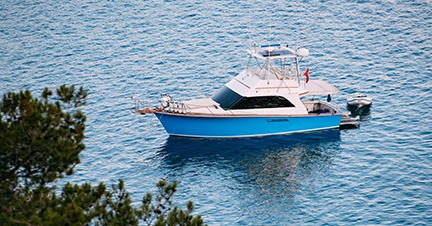
I met my new friend on the dock and after exchanging some pleasantries, we boarded his dinghy with my gear bag to head back to the trawler now sitting quietly at anchor in the river. He drove like an old islander he had met long ago, standing upright in the dinghy, holding firmly to the bow line for balance while using a tiller extension to steer. With his Benson captains' hat, he certainly cut a unique figure. All he needed was a pipe and a rain slicker to complete the look. [PLEASE CLICK ON TITLE ABOVE TO CONTINUE READING]
|
We were to spend the next week together on his vessel, sharing experiences and knowledge gained over what I realized was a boating resume of over 100 years combined seasoning! We took turns instructing and learning, moving seamlessly between the roles of teacher and student. He peppered his lessons with oft repeated quotes that I could tell were used for newcomers aboard his boat. One of the most poignant for me was: "It's not what you see that gets you in trouble, it's what you don't see". That set my brain on fire. My first thought was to look at this as a zero-sum game. I reasoned that the more that I am able to see, then the less there must be out there that I can’t see. If that's indeed the case, then how do I have to do to "see" more and thus reduce my risk? It's easy to answer that as it relates to boating... use look-outs, pay attention, radar, read the weather, understand navigational markers and lights, etc. But since I stretched this admonition to a life lesson, I started asking myself these kinds of questions: what can I do to really see more; how do I open my eyes, become more observant, more curious, more insightful, more in-tuned with all that is happening around me; how do I see around the corner, physically and temporally; how do I begin to really see things that I would have otherwise missed? Before even attempting to answer those questions, I laughed as I thought about Mark Twain's twist on this advice: "It's not what we don't know that gets us in trouble. It's what we know for sure that just ain't so". I was brought back to earth with Henry David Thoreau's: "It's not what you look at that matters, it's what you see." And then Marcel Proust's version challenged me deeper: "The real voyage of discovery consists not in seeing new sights, but in looking with new eyes". During an airplane ride to quietly think about it, here's what I came up with as some answers: 1. Be aware of your instincts, and trust them. 2. Ask questions. Listen actively. Then ask more questions. 3. Ask questions of yourself and keep asking until you feel like you have a better understanding or awareness. 4. Pay more attention to others, what they are doing, what they are saying, what they are not saying, their body language. 5. Use all five of your senses to "see" more. 6. Take notes, read over them, then ask "what's missing" and go find the answers. 7. Get rid of distractions; put down your phone. It hinders you from being present. 8. Slow down... don't rush through things. OK, just a handful of ideas. I think my captain friend would be good with that. When I called him recently, he told me simply that he was still admiring the scenery sitting in paradise. I smiled thinking that it must just be easier to see more there. |